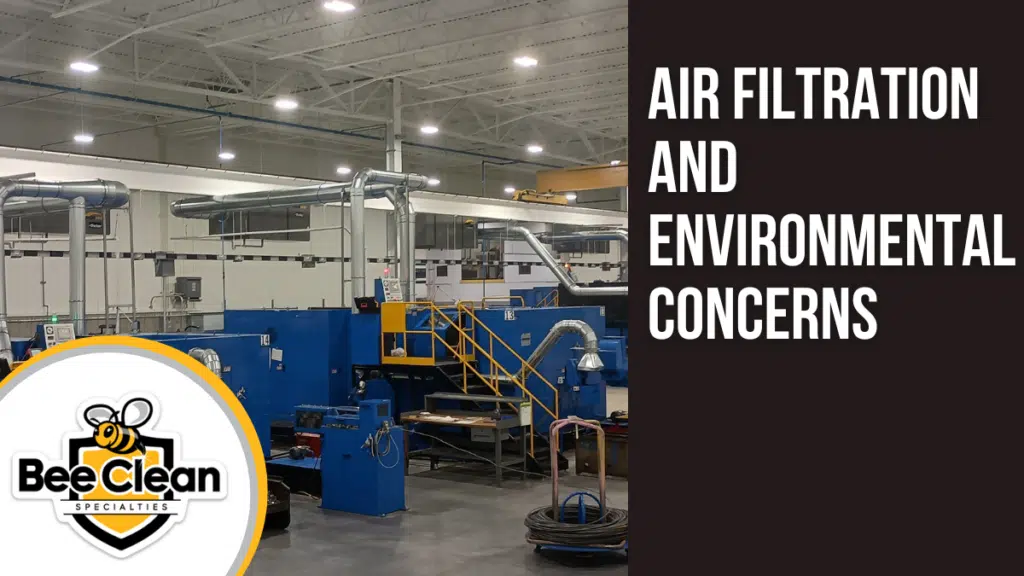Air Filtration and Environmental Concerns

The hundreds of options for air filtration make choosing the right system for you can be quite difficult. There are many different factors to consider. One of the most talked about recently is environmental impact. Any type of air filtration system is good for the environment of the factory where it is installed, but some types have a larger impact on the environment as a whole. If achieving net zero, or zero waste is something that is important to you, it is something to be considered when choosing an air filtration system.
Waste to the Landfill: One of the most obvious environmental impacts of most types of air filtration systems are the dirty filters. Once the filters have lived their useful life, most types of filters are discarded. This can cause even more of a headache than regular waste disposal, because of the fact that dirty filters are often considered Hazmat unless they are lab tested.
Media filtration uses disposable filters as its method of filtration, so it inherently has a lot of waste that goes to the landfill. Making sure that you pick the right filter for the job is important to minimize waste as well as the cost as much as possible.
Centrifugal filtration uses a rotating drum to collect the majority of the particles. This limits the amount of waste to the landfill, however, most types of centrifugal or spinner-type filtration systems still use disposable pads in the drum to increase the rate of capture, as well as using some type of after-filter to increase efficiency if they are used on difficult applications.
Electrostatic filtration does not use disposable filters, and a majority of the pollutant collected drains back off the aluminum collection cell. If you have your filters professionally cleaned, the remaining particles that are left on the cell will be washed off and separated from the cleaning solution to be recycled.
Energy Consumption: Low energy consumption is an economic concern as well as an environmental concern. Usually the higher the pressure drop across a filter (air restriction) the more energy is required, to filter the same amount of air.
Media filtration has variable pressure drop over the useful length of filter life. It starts out relatively low and becomes more restrictive over time until the filters need to be changed again. This means that the motor needs to pull enough airflow to overcome the pressure drop of the dirty filter and that extra energy is wasted on clean filters. This is why on larger media filtration systems, variable frequency drives (VFD) are a good investment. These reduce energy consumption when the filters are clean, and ramp it up when it is needed.
Centrifugal filtration also uses a high level of energy in comparison to the amount of CFM that it filters. This is because the separator drum needs to be spun quickly in order for it to work.
Electrostatic filtration uses the least amount of energy per CFM, because the electrostatic cell has very little restriction. This also means that it is consistent throughout the service life of the electrostatic cell, so a VFD is not required to optimize electricity consumption.
Check out this video to see a comparison between centrifugal and electrostatic filtration energy costs: link
Ozone Generation is sometimes a concern associated with electrostatic filtration. Media and centrifugal-type filtration do not produce any ozone. In reality, when electrostatic filters were tested in test chambers and in actual homes, the ozone levels generated measured from 0.005 to 0.020 parts per million (PPM). In another study, electronic air cleaners were tested to not exceed 0.030 PPM above ambient levels of ozone. These numbers are well below safety standards set by the US government, and are frequently below the outdoor ozone levels. Up to 0.054 PPM is considered a healthy ozone level for the outside air.
If you have any further questions about the environmental impacts of your air filtration system, give us a call. 847.451.0844
Sources:
https://www.airnow.gov/sites/default/files/2021-03/air-quality-guide_ozone_2015.pdf
https://airquality.weather.gov/sectors/illinois.php#tabs
https://www.honeywellhome.com/us/en/support/f300-electronic-air-cleaner-2/